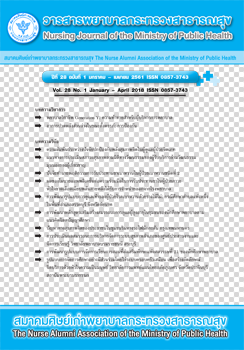The Prevention of Low Back Pain during Pregnancy
Main Article Content
Abstract
Lower back pain during pregnancy is a frequently reported cause of discomfort due to
physiological and hormonal changes that can affect everyday life of pregnant women. It also affects
their abilities to function including health status during antepartum, delivery and postpartum period
resulting slow movement, sleep disturbance and chronic back pain in postpartum period. These
problems decrease the quality of life of pregnant women and can increase the use of sick leave,
inability to perform function and worsen their family’s economic situation. Lower back pain
during pregnancy can be prevented or relieved with health education about appropriate posture,
exercise and back muscle massage. The objective of this article was to present information about
th prevalence, effect, and correlative factors that induce low back pain during pregnancy and
methods for the prevention or relieve of lower back pain during pregnancy. This information can
serve as guidelines for the prevention or relieve of lower back pain during pregnancy, so that
pregnant woman can live with happiness and improved quality of life.
Article Details
บทความและรายงานวิจัยในวารสารพยาบาลกระทรวงสาธารณสุข เป็นความคิดเห็นของ ผู้เขียน มิใช่ของคณะผู้จัดทำ และมิใช่ความรับผิดชอบของสมาคมศิษย์เก่าพยาบาลกระทรวงสาธารณสุข ซึ่งสามารถนำไปอ้างอิงได้
References
2. Cheng PL, et al. Back pain of working pregnant women: Identification of associated occupational factors. Applied Ergonomics 2009;40: 419-23.
3. Mogren IM. BMI, pain and hyper-mobility are determinants of long-term outcome for women with low back pain and pelvic pain during pregnancy. Europe Spine Journal 2006;15: 1093 -102.
4. Vleeming A, Albert HB, Östagaard HC, Sturesson B, Stuge B. European guidelines for the diagnosis and treatment of pelvic pain. Europe Spine journal 2008;17: 794-819.
5. Keriakos R, Chaudhuri Bhatta, SR Morris F, Mason S, Buckley S. Pelvic girdle pain during pregnancy and puerperium. Journal of Obstetrics and Gynecology 2011; 31: 572- 80.
6. Fitzgerald CM, Santos LR, Mallinson T. The association between pelvic girdle pain and urinary incontinence among pregnant women in the second trimester. International Journal of Gynecology and Obstetrics 2012; 117: 248-50.
7. Coad J. Anatomy and physiology for midwives. 3rd ed. Edinburgh: Livingstone. 2011.
8. Sneag DB, Bendo JA. Pregnancyrelated low back pain. Orthopedics 2007; 30(10):839–45.
9. Sabino J, Grauer JN. Pregnancy and low back pain. Curr Rev Musculoskeletal Medicine 2008; 1: 137–41.
10. Bjelland EK, Eskild A, Johansen R, Eberhard-Gran. M. Pelvic girdle pain in pregnancy: the impact of parity. American
Journal of Obstetrics and Gynecology 2010; 203(2): 146.e1–146.e6.
11. Mahawanakul S, Chaiwanichsiri D. Gestational back pain in Chulalongkorn antenatal care clinic. Journal Thai Rehabilitation Medicine 1999; 9(1): 33 - 40. In Thai.
12. Larsen PS, Streandberg-Larsen K, Juhl, M, Svendsen Occupational lifting and pelvic pain during pregnancy: a study within the Danish National Birth Cohort. Scandinavian journal of work, Environment & Health 2013; 39(1): 88-95.
13. Biering K, Aagaard Nohr E, Olsen J, Hjollund NH, Nybo Anderson A-M, Juhl M. Pregnancy-related pelvic pain is more frequent in woman with increase body mass index. Acta Obstetricia et Gynecologica 2011; 90: 1132-1139.
14. Mohseni-Bandpei MA, Fakhri M, Ahmad Shirvani M, Bagheri-Nessami M, Khalilian AR, et al. Low back pain in 1,100 Iranian pregnant women: prevalence and risk factors. The spinal journal 2009; 9: 795-801.
15. Biering K, Aagaard Nohr E, Olsen J, Hjollund NH, Nybo Anderson, A-M, Juhl M. Smoking and pregnancy-related pelvic pain. BJOG An International Journal of Obstetrics and Gynaecology 2010; [electronic version]: 1019-26.
16. Robinson SH, Eskild A, Heiberg E, Eberhard Gran M. Pelvic girdle pain in pregnancy: The impact on function. Acta Obstetricia et Gynecologica 2006; 85: 160-4.
17. Robinson HS, Veierød MB, Mengshoel AM, Vøllestad NK, Pelvic girdle pain associations between risk factors in early pregnancy and disability or pain intensity in late pregnancy: a prospective cohort study. BMC musculoskeletal Disorders 2010; 11: 91.
18. Dørheim SK, Bjorvatn B, Eberhard-Gran, M. Sick leave during pregnancy: a longitudinal study of rates and risk factors in a Norwegian population. BIOG aninternational journal of Obstetrics and Gynecology 2012; [electronic version]: 1-10.
19. Shim M-J, Lee Y-S, Oh H-E, Kim J-S. Effect of a back-pain-reducing program during pregnancy for Korean woman: A non-equivalent control-group pretest-posttest study. International journal of nursing studies 2007; 44: 19-28.
20. Kluge J, Hall D, Louw Q, Theron G, Grove D, Specific exercises to treat pregnancy-related low back pain in a South African population. International journal of Gynecology and Obstetrics 2011; 113: 187-91.
21. Jannarong N. The effect of low back pain management program on pain level and disability of pregnant woman [Thesis of M.N.S. of maternity and newborn nursing]. Bangkok. Faculty of graduate studies, Mahidol university. 2006. In Thai.
22. Stafne SN, Salvesen KA, Romundstad PR, Stuge B, Mørkved S. Does regularexercise during pregnancy influence lumbopelvic pain? A randomized controlled trial. Acta Obstetricia et Gynecologica Scandinavica 2012; 91: 552-9.
23. Garshasbi A, Zadeh SF. The effect of exercise on the intensity of low back pain in pregnant woman. International Journal of
Gynecology and Obstetrics 2005; 88: 271-5.
24. ACOG Committee opinion. Number 267, January 2002: Exercise during pregnancy and the postpartum period. International Journal of Gynecology and Obstetrics 2002; 77: 79-81.
25. Eggen HM, Stuge B, Mowinckel P, Jensen SK, & Hagen BK. Can supervised group exercise including ergonomic advice reduce the prevalence and severity of low back pain and pelvic girdle pain in pregnancy a randomized controlled trial. Physical therapy 2012; 92(6): 781–90.

